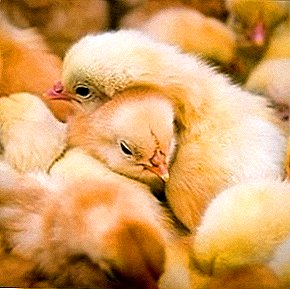
Infectious diseases pose a threat not only to animals prone to the disease, but also to humans.
For example, the source of Salmonella, found in food on the markets and in stores, most often becomes the meat of poultry grown for sale.
Therefore, it is necessary to know the main symptoms, preventive measures and treatment of such a dangerous infectious disease as pullorosis-typhoid.
Pullorosis- (typhoid, bacillary dysentery, white bacillary diarrhea, white bacillary diarrhea) is a dangerous infectious disease that is acute in young birds and is chronic, asymptomatic in adults.
What is pullorosis?
Disease prone to poultry: chickens, turkeys, ducks (especially young), as well as wild birds: quail, pheasants, guinea fowls. The most acute outbreaks of the disease are observed in chickens from birth to 2 weeks of age.
 Pulloz-typhus was first discovered in the United States (Connecticut) in 1900 by Retger. Over time, this disease has become widespread in the United States and other countries.
Pulloz-typhus was first discovered in the United States (Connecticut) in 1900 by Retger. Over time, this disease has become widespread in the United States and other countries.
In the USSR, the disease was discovered in 1924 by Academician Ushakov. Pulloz-typhus was introduced into an alliance with imported chickens, breeding chickens and turkeys, their eggs.
The infection is currently registered in many poultry farms and industrial factories for the production and supply of poultry meat, chicken eggs to markets and shops.
Distribution and vectors
 The disease is recorded in all countries.
The disease is recorded in all countries.
The offspring of infected individuals during the formation of eggs in the ovaries of sick birds, chickens born to infected individuals infect healthy offspring. The disease is characterized by stationarity.
Disease transmission can be carried out through infected eggs and incubators, water, feed, droppings of sick birds, unfertilized eggs, shells, objects for the care of sick birds, and spreading are also promoted by roosters.
The vectors are small rodents, sparrows, starlings, tits, bullfinches, daws and other free-living birds.
Degree of danger and damage
 Without taking effective measures to eliminate acute outbreaks of pullorosis-typhoid, the disease affects all birds, the incidence of young offspring reaches 70%, for them pullorosis-typhoid is the most dangerous.
Without taking effective measures to eliminate acute outbreaks of pullorosis-typhoid, the disease affects all birds, the incidence of young offspring reaches 70%, for them pullorosis-typhoid is the most dangerous.
Lethal outcome for poultry is 80%if time does not take therapeutic and preventive measures.
Salmonella, which enter the human body through the meat of sick birds, cause acute intestinal poisoning, accompanied by high fever, vomiting, diarrhea, abdominal pain, fever, and intoxication.
Patients with salmonellosis are hospitalized to infectious departments.
Pathogens
 The disease causes Salmonellapullorum-Gallinarum (Salmonella pullorum-gallinarum) - bacteria that are short (1-2 microns long and 0.3-0.8 microns thick) fixed sticks, they do not form capsules or spores.
The disease causes Salmonellapullorum-Gallinarum (Salmonella pullorum-gallinarum) - bacteria that are short (1-2 microns long and 0.3-0.8 microns thick) fixed sticks, they do not form capsules or spores.
In the litter of sick birds, bacteria persist for up to 100 days, in the soil - more than 400 days, in water - up to 200 days, they can also persist in the dead bodies of sick individuals (up to 40 days).
Bacteria at room temperature indoors retain biological properties for 7 years, but high temperatures destroy them. So at a temperature of 60 ° C, bacteria are destroyed in half an hour, up to 100 ° C - in 1 minute, while cooking eggs - in 8 minutes.
Naturally resistant Salmonella is extremely sensitive to chemical attack, they are destroyed by formaldehyde, bleach, carbolic acid solutions.
Symptoms in different course
 In the acute course of the disease in birds are observed:
In the acute course of the disease in birds are observed:
- white faeces;
- depression;
- diarrhea;
- lack of coordination of movements;
- nervousness;
- coma;
- lethargy;
- power failure;
- glued fluff near the cloaca;
- the omission of the wings.
Symptoms of subacute course:
- poor plumage;
- boiler inflammation of foot joints;
- impaired digestion;
- labored breathing;
- elevated temperature to (45 ° C).
 It is known that Firewall chickens from the very birth differ in appearance and very quickly gain weight.
It is known that Firewall chickens from the very birth differ in appearance and very quickly gain weight.Are your birds sick with a simple gonosis? Then rather read: //selo.guru/ptitsa/kury/bolezni/k-virusnye/prostogonimoz.html.
Chronic course:
- growth retardation;
- developmental delay;
- peritonitis (biliary or fibrinous);
- salpingitis;
- hyperthermia;
- thirst;
- lack of appetite;
- weakness.
The incubation period is up to 20 days. The peculiarity lies in the fact that birds that have suffered a disease receive immunity and are not infected again.
Diagnostics
 Diagnosis is complex, takes into account all the symptoms, data, analyzes the overall clinical picture, all the changes that occur in the body of sick individuals.
Diagnosis is complex, takes into account all the symptoms, data, analyzes the overall clinical picture, all the changes that occur in the body of sick individuals.
But the final diagnosis is made only according to the results of bacteriological research, when the culture of the pathogen is isolated in its pure form. The objects of this study will be:
- the corpses of sick birds;
- liver;
- gallbladder;
- kidneys;
- a heart;
- spleen;
- blood;
- eggs of sick animals.
For intravital establishment of the disease, a serological method is used - the blood-and-agglutination agglutination reaction (CCRA) on glass and the blood-and-blood reaction of indirect hemagglutination with the erythrocyte pullore antigen (CCRNA).
Treatment and Prevention
 Basic measures:
Basic measures:
- transfer of sick individuals and weakened chickens for slaughter.
- isolation of young individuals from infected.
- proper feeding of domestic birds, corresponding to their age and appearance.
- treatment and prophylactic measures in relation to healthy individuals, namely, the use of a complex method, which consists in combining drugs of the furan series (sulfanilamide) in combination with antibiotics (chlortetracycline hydrochloride, tetracycline, etc.). The most effective drugs are furazolidone and furaltadone.
- monthly carrying out a blood-and-agglutination reaction until a negative result is obtained.
- maintaining the hygiene of the premises where the birds and incubators are kept, their regular cleaning and disinfection.
- Carcases of bacilli carriers can be used in the food industry if they do not have clinical signs.
To prevent and eliminate infection, comprehensive therapeutic and preventive measures, bacteriological studies and the destruction of infected individuals should be carried out.












